Radar Observation of the Lava Tubes on the Moon and Mars
Abstract
:1. Introduction
2. Mechanisms of Lava Tube Formation on the Moon and Mars
3. The Principle of GPR to Detect Lava Tubes
3.1. Orbiting Radar Sounders
3.2. In Situ Ground Penetrating Radar
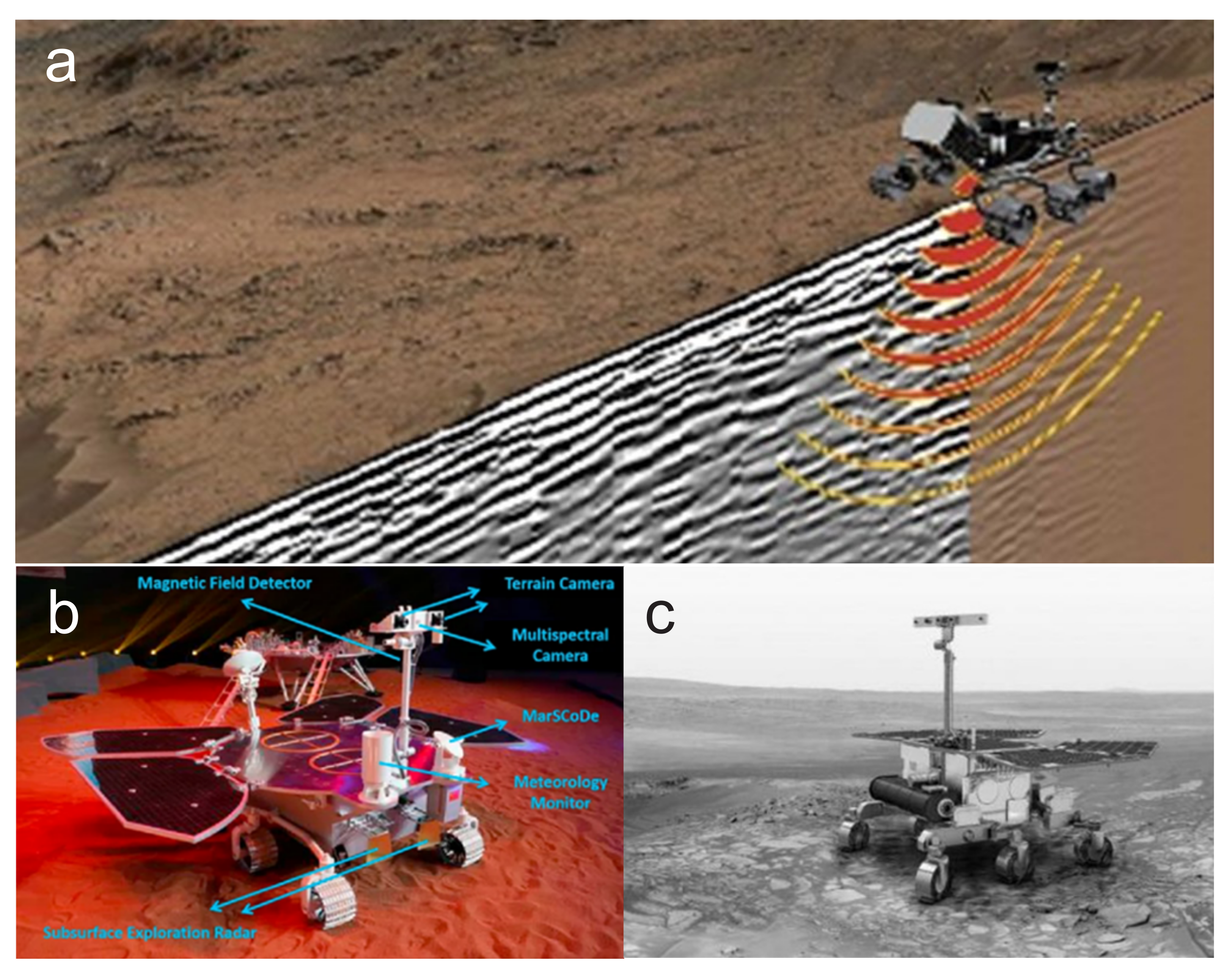
4. Ground Penetrating Radar for Exploring Lava Tubes
4.1. Physical Properties of Lava Tubes
4.1.1. Morphological Properties of Lava Tubes
4.1.2. Dielectric Properties of Lava Tubes
4.2. Radar Echo Features of Lava Tubes
- Perpendicular (the radar motion trajectory is perpendicular to the axis of the lava tube);
- Center–parallel (the radar moves along the axis of the lava tube);
- Off–center parallel (the radar deviates from the axis of the lava tube but remains parallel to it);
- Diagonal (the radar moves at a certain angle to the axis of the lava tube). These scanning methods are shown in Figure 8.
4.3. Mechanisms of Radar Detection of Lava Tubes
- Two vertically aligned hyperbolic curves are formed, with a bright hyperbolic curve hanging over some more disordered and darker echoes.
- The phase difference between the radar echoes of the two curves is 180°.
- Collect radar data and subject them to preprocessing;
- Denoise the data and extract the apparent hyperbolic curve echoes from the potential cavity areas;
- Extract the polarity of the echo signal at the cavity’s upper edge and compare it with the polarity of the incident wave to make a preliminary judgment;
- Estimate the dielectric properties (dielectric constant and loss tangent) of the cavity and surrounding non–cavity areas and compare their differences;
- Make a final judgment and output the result.
4.4. TubeX Project
5. Distribution of Lava Tubes on the Moon
- Image detection involves analyzing the surface images of celestial bodies to detect possible lava tubes. This method can indirectly discover some anomalies on the surfaces of celestial bodies, such as skylights and collapsed lava tubes, but cannot directly detect the interior of lava tubes.
- Radar detection, as discussed in this paper, can detect the location of lava tubes at deeper layers compared to image detection, with the advantages of high resolution, high sensitivity, and fewer interferences from other features on extraterrestrial surfaces.
- Direct detection involves using rovers or other equipment to enter the lava tube and measure the physical quantities including temperature, gas composition, and magnetic field fluctuations to analyze the lava tube’s structure, composition, and characteristics. This method requires advanced technology and is challenging to operate, but it can reveal more detailed lava tube structures and features.
6. Distribution of Lava Tubes on Mars
7. The Potential Utilization of Lava Tubes: Indications to the Sites for Future Bases on the Moon and Mars
8. Conclusions and Perspectives
Author Contributions
Funding
Conflicts of Interest
Correction Statement
References
- Ding, C.; Feng, J.; Zheng, L.; Dai, S.; Xing, S.; Xiao, Y.; Su, Y. A Review of Applications of Radar-Detection Techniques in Lunar Explorations. Astron. Res. Technol. 2015, 12, 228–242. [Google Scholar] [CrossRef]
- Zheng, Y.C. Mars exploration in 2020. Innovation 2020, 1, 100036. [Google Scholar] [CrossRef]
- Crawford, I.; Anand, M.; Cockell, C.; Falcke, H.; Green, D.; Jaumann, R.; Wieczorek, M. Back to the Moon: The scientific rationale for resuming lunar surface exploration. Planet. Space Sci. 2012, 74, 3–14. [Google Scholar] [CrossRef] [Green Version]
- Burns, J.A. The four hundred years of planetary science since Galileo and Kepler. Nature 2010, 466, 575–584. [Google Scholar] [CrossRef] [PubMed]
- Carr, M.H. The Surface of Mars; Cambridge University Press: Cambridge, UK, 2007; Volume 6. [Google Scholar]
- Carrier, W.D., III; Olhoeft, G.R.; Mendell, W. Physical Properties of the Lunar surface. Lunar Sourcebook, a User’s Guide to the Moon; Cambridge University Press: Cambridge, UK, 1991; pp. 475–594. [Google Scholar]
- Ding, C.; Xiao, Z.; Su, Y. A potential subsurface cavity in the continuous ejecta deposits of the Ziwei crater discovered by the Chang’E-3 mission. Earth Planets Space 2021, 73, 53. [Google Scholar] [CrossRef]
- Sauro, F.; Pozzobon, R.; Massironi, M.; De Berardinis, P.; Santagata, T.; De Waele, J. Lava tubes on Earth, Moon and Mars: A review on their size and morphology revealed by comparative planetology. Earth-Sci. Rev. 2020, 209, 103288. [Google Scholar] [CrossRef]
- Blair, D.M.; Chappaz, L.; Sood, R.; Milbury, C.; Bobet, A.; Melosh, H.J.; Howell, K.C.; Freed, A.M. The structural stability of lunar lava tubes. Icarus 2017, 282, 47–55. [Google Scholar] [CrossRef]
- Elachi, C.; Cimino, J.; Settle, M. Overview of the Shuttle Imaging Radar-B preliminary scientific results. Science 1986, 232, 1511–1516. [Google Scholar] [CrossRef] [PubMed]
- Fang, G.Y.; Zhou, B.; Ji, Y.C.; Zhang, Q.Y. Lunar Penetrating Radar onboard the Chang’e-3 mission. Res. Astron. Astrophys. 2014, 14, 1607. [Google Scholar] [CrossRef]
- Hamran, S.E.; Paige, D.A.; Amundsen, H.E.F.; Berger, T.; Brovoll, S.; Carter, L.; Damsgård, L.; Dypvik, H.; Eide, J.; Eide, S.; et al. Radar Imager for Mars’ Subsurface Experiment—RIMFAX. Space Sci. Rev. 2020, 216, 128. [Google Scholar] [CrossRef]
- Li, C.; Wang, C.; Wei, Y.; Lin, Y. China’s present and future lunar exploration program. Science 2019, 365, 238–239. [Google Scholar] [CrossRef]
- Ono, T.; Kumamoto, A.; Nakagawa, H.; Yamaguchi, Y.; Oshigami, S.; Yamaji, A.; Kobayashi, T.; Kasahara, Y.; Oya, H. Lunar Radar Sounder Observations of Subsurface Layers Under the Nearside Maria of the Moon. Science 2009, 323, 909–912. [Google Scholar] [CrossRef] [PubMed] [Green Version]
- Seu, R.; Phillips, R.J.; Biccari, D.; Orosei, R.; Masdea, A.; Picardi, G.; Safaeinili, A.; Campbell, B.A.; Plaut, J.J.; Marinangeli, L.; et al. SHARAD sounding radar on the Mars Reconnaissance Orbiter. J. Geophys. Res. Planets 2007, 112, E5. [Google Scholar] [CrossRef]
- Zhou, B.; Shen, S.; Lu, W.; Liu, Q.; Tang, C.; Li, S.; Fang, G. The Mars rover subsurface penetrating radar onboard China’s Mars 2020 mission. Earth Planet. Phys. 2020, 4, 345–354. [Google Scholar] [CrossRef]
- Jol, H.M. Ground Penetrating Radar Theory and Applications; Elsevier: Amsterdam, The Netherlands, 2008. [Google Scholar]
- Esmaeili, S.; Kruse, S.; Jazayeri, S.; Whelley, P.; Bell, E.; Richardson, J.; Garry, W.B.; Young, K. Resolution of Lava Tubes With Ground Penetrating Radar: The TubeX Project. J. Geophys. Res. Planets 2020, 125, e2019JE006138. [Google Scholar] [CrossRef]
- Kaku, T.; Haruyama, J.; Miyake, W.; Kumamoto, A.; Ishiyama, K.; Nishibori, T.; Yamamoto, K.; Crites, S.T.; Michikami, T.; Yokota, Y.; et al. Detection of Intact Lava Tubes at Marius Hills on the Moon by SELENE (Kaguya) Lunar Radar Sounder. Geophys. Res. Lett. 2017, 44, 10155–10161. [Google Scholar] [CrossRef]
- Brož, P.; Bernhardt, H.; Conway, S.J.; Parekh, R. An overview of explosive volcanism on Mars. J. Volcanol. Geotherm. Res. 2021, 409, 107125. [Google Scholar] [CrossRef]
- Ivanov, B.A. Mars/Moon Cratering Rate Ratio Estimates. Space Sci. Rev. 2001, 96, 87–104. [Google Scholar] [CrossRef]
- Spudis, P.D. Chapter 39—Volcanism on the Moon. In The Encyclopedia of Volcanoes, 2nd ed.; Sigurdsson, H., Ed.; Academic Press: Amsterdam, The Netherlands, 2015; pp. 689–700. [Google Scholar] [CrossRef]
- Valerio, A.; Tallarico, A.; Dragoni, M. Mechanisms of formation of lava tubes. J. Geophys. Res. Solid Earth 2008, 113. [Google Scholar] [CrossRef]
- Haruyama, J.; Morota, T.; Kobayashi, S.; Sawai, S.; Lucey, P.G.; Shirao, M.; Nishino, M.N. Lunar holes and lava tubes as resources for lunar science and exploration. In Moon: Prospective Energy and Material Resources; Springer: Berlin/Heidelberg, Germany, 2012; pp. 139–163. [Google Scholar]
- Horz, F. Lava tubes-potential shelters for habitats. In Lunar Bases and Space Activities of the 21st Century; Lunar and Planetary Institute: Houston, TX, USA, 1985; pp. 405–412. [Google Scholar]
- Benaroya, H. Turning Dust to Gold: Building a Future on the Moon and Mars; Springer Science & Business Media: Berlin/Heidelberg, Germany, 2016. [Google Scholar]
- Léveillé, R.J.; Datta, S. Lava tubes and basaltic caves as astrobiological targets on Earth and Mars: A review. Planet. Space Sci. 2010, 58, 592–598. [Google Scholar] [CrossRef]
- Kauahikaua, J.; Cashman, K.V.; Mattox, T.N.; Heliker, C.C.; Hon, K.A.; Mangan, M.T.; Thornber, C.R. Observations on basaltic lava streams in tubes from Kilauea Volcano, island of Hawai’i. J. Geophys. Res. Solid Earth 1998, 103, 27303–27323. [Google Scholar] [CrossRef]
- Bell, E.; Schmerr, N.; Young, K.; Esmaeili, S.; Garry, W.B.; Jazayeri, S.; Kruse, S.; Richardson, J.; Whelley, P. Field Mapping and Modeling of Terrestrial Lava Tube Magnetic Anomalies as an Analog for Lunar Lava Tube Exploration and Prospecting. J. Geophys. Res. Planets 2022, 127, e2021JE007140. [Google Scholar] [CrossRef]
- Sharygin, V.V.; Kamenetsky, V.S.; Zhitova, L.M.; Belousov, A.B.; Abersteiner, A. Copper-Containing Magnesioferrite in Vesicular Trachyandesite in a Lava Tube from the 2012–2013 Eruption of the Tolbachik Volcano, Kamchatka, Russia. Minerals 2018, 8, 514. [Google Scholar] [CrossRef] [Green Version]
- Crown, D.A.; Scheidt, S.P.; Berman, D.C. Distribution and Morphology of Lava Tube Systems on the Western Flank of Alba Mons, Mars. J. Geophys. Res. Planets 2022, 127, e2022JE007263. [Google Scholar] [CrossRef]
- Duraiswami, R.A.; Bondre, N.R.; Managave, S. Morphology of rubbly pahoehoe (simple) flows from the Deccan Volcanic Province: Implications for style of emplacement. J. Volcanol. Geotherm. Res. 2008, 177, 822–836. [Google Scholar] [CrossRef]
- Hon, K.; Kauahikaua, J.; Denlinger, R.; Mackay, K. Emplacement and inflation of pahoehoe sheet flows: Observations and measurements of active lava flows on Kilauea Volcano, Hawaii. Geol. Soc. Am. Bull. 1994, 106, 351–370. [Google Scholar] [CrossRef]
- Peterson, D.W.; Holcomb, R.T.; Tilling, R.I.; Christiansen, R.L. Development of lava tubes in the light of observations at Mauna Ulu, Kilauea Volcano, Hawaii. Bull. Volcanol. 1994, 56, 343–360. [Google Scholar] [CrossRef]
- Theinat, A.K.; Modiriasari, A.; Bobet, A.; Melosh, H.J.; Dyke, S.J.; Ramirez, J.; Maghareh, A.; Gomez, D. Lunar lava tubes: Morphology to structural stability. Icarus 2020, 338, 113442. [Google Scholar] [CrossRef]
- Daniels, D.J. Ground Penetrating Radar; IET: Stevenage, UK, 2004; Volume 1. [Google Scholar]
- Zeng, Z.; Liu, S.; Xuan, F. Principle and Application of Ground Penetrating Radar; Beijing Electronics Industry Press: Beijing, China, 2010. [Google Scholar]
- Porcello, L.J.; Jordan, R.L.; Zelenka, J.S.; Adams, G.F.; Phillips, R.J.; Brown, W.E.; Ward, S.H.; Jackson, P.L. The Apollo lunar sounder radar system. Proc. IEEE 1974, 62, 769–783. [Google Scholar] [CrossRef]
- Platz, T.; Byrne, P.K.; Massironi, M.; Hiesinger, H. Volcanism and tectonism across the inner solar system: An overview. Geol. Soc. London, Spec. Publ. 2015, 401, 1–56. [Google Scholar] [CrossRef]
- Ono, T.; Oya, H. Lunar Radar Sounder (LRS) experiment on-board the SELENE spacecraft. Earth Planets Space 2000, 52, 629–637. [Google Scholar] [CrossRef] [Green Version]
- Ohtake, M.; Haruyama, J.; Matsunaga, T.; Yokota, Y.; Morota, T.; Honda, C.; LISM Team. Performance and scientific objectives of the SELENE (KAGUYA) Multiband Imager. Earth Planets Space 2008, 60, 257–264. [Google Scholar] [CrossRef] [Green Version]
- Carrer, L.; Gerekos, C.; Bruzzone, L. A multi-frequency radar sounder for lava tubes detection on the Moon: Design, performance assessment and simulations. Planet. Space Sci. 2018, 152, 1–17. [Google Scholar] [CrossRef]
- Wang, R.; Yan, S. A Review of Application of Surface Penetrating Radar in the Moon and Deep-space Exploration. Astron. Res. Technol. 2020, 17, 492–512. [Google Scholar]
- Ono, T.; Kumamoto, A.; Kasahara, Y.; Yamaguchi, Y.; Yamaji, A.; Kobayashi, T.; Oshigami, S.; Nakagawa, H.; Goto, Y.; Hashimoto, K.; et al. The Lunar Radar Sounder (LRS) Onboard the KAGUYA (SELENE) Spacecraft. Space Sci. Rev. 2010, 154, 145–192. [Google Scholar] [CrossRef]
- Zuber, M.T.; Smith, D.E.; Watkins, M.M.; Asmar, S.W.; Konopliv, A.S.; Lemoine, F.G.; Melosh, H.J.; Neumann, G.A.; Phillips, R.J.; Solomon, S.C. Gravity field of the Moon from the Gravity Recovery and Interior Laboratory (GRAIL) mission. Science 2013, 339, 668–671. [Google Scholar] [CrossRef] [Green Version]
- Crawford, I.A.; Joy, K.H. Lunar exploration: Opening a window into the history and evolution of the inner Solar System. Philos. Trans. R. Soc. A Math. Phys. Eng. Sci. 2014, 372, 20130315. [Google Scholar] [CrossRef] [Green Version]
- Kobayashi, T.; Kim, J.H.; Lee, S.R. HF (5 MHz) imaging of the moon by Kaguya lunar radar sounder off nadir echo data. IEEE Trans. Geosci. Remote Sens. 2018, 56, 3709–3714. [Google Scholar] [CrossRef]
- Sood, R.; Melosh, H.J.; Howell, K.C. Lunar Advanced Radar Orbiter for Subsurface Sounding (Laross): Lava Tube Exploration Mission. In Proceedings of the 26th AAS/AIAA Space Flight Mechanics Meeting, Napa, CA, USA, 14–18 February 2016; Volume 158, pp. 3823–3837. [Google Scholar]
- Jordan, R.; Picardi, G.; Plaut, J.; Wheeler, K.; Kirchner, D.; Safaeinili, A.; Johnson, W.; Seu, R.; Calabrese, D.; Zampolini, E. The Mars express MARSIS sounder instrument. Planet. Space Sci. 2009, 57, 1975–1986. [Google Scholar] [CrossRef]
- Li, C.; Zhang, R.; Yu, D.; Dong, G.; Liu, J.; Geng, Y.; Sun, Z.; Yan, W.; Ren, X.; Su, Y.; et al. China’s Mars Exploration Mission and Science Investigation. Space Sci. Rev. 2021, 217, 57. [Google Scholar] [CrossRef]
- Fan, M.; Lyu, P.; Su, Y.; Du, K.; Zhang, Q.; Zhang, Z.; Dai, S.; Hong, T. The Mars Orbiter Subsurface Investigation Radar (MOSIR) on China’s Tianwen-1 Mission. Space Sci. Rev. 2021, 217, 8. [Google Scholar] [CrossRef]
- XIONG, S. Orbiter-based subsurface sounding radar for searching water ice on Mars. ACTA Geol. Sin. 2021, 95, 2823–2842. [Google Scholar] [CrossRef]
- Seu, R.; Biccari, D.; Orosei, R.; Lorenzoni, L.; Phillips, R.; Marinangeli, L.; Picardi, G.; Masdea, A.; Zampolini, E. SHARAD: The MRO 2005 shallow radar. Planet. Space Sci. 2004, 52, 157–166. [Google Scholar] [CrossRef]
- Orosei, R.; Ding, C.; Fa, W.; Giannopoulos, A.; Hérique, A.; Kofman, W.; Lauro, S.E.; Li, C.; Pettinelli, E.; Su, Y.; et al. The global search for liquid water on Mars from orbit: Current and future perspectives. Life 2020, 10, 120. [Google Scholar] [CrossRef]
- Hong, T.; Su, Y.; Fan, M.; Dai, S.; Lv, P.; Ding, C.; Zhang, Z.; Wang, R.; Liu, C.; Du, W.; et al. Flight Experiment Validation of Altitude Measurement Performance of MOSIR on Tianwen-1 Orbiter. Remote Sens. 2021, 13, 5049. [Google Scholar] [CrossRef]
- Hong, T.; Su, Y.; Dai, S.; Zhang, Z.; Du, W.; Liu, C.; Liu, S.; Wang, R.; Ding, C.; Li, C. An Improved Method of Surface Clutter Simulation Based on Orbiting Radar in Tianwen-1 Mars Exploration. Radio Sci. 2022, 57, e2022RS007491. [Google Scholar] [CrossRef]
- Ding, C.; Li, Q.; Xu, J.; Lei, Z.; Li, J.; Su, Y.; Huang, S. Moon-Based Ground Penetrating Radar Derivation of the Helium-3 Reservoir in the Regolith at the Chang’E-3 Landing Site. IEEE J. Sel. Top. Appl. Earth Obs. Remote Sens. 2023, 16, 2764–2776. [Google Scholar] [CrossRef]
- Li, C.; Xing, S.; Lauro, S.E.; Su, Y.; Dai, S.; Feng, J.; Cosciotti, B.; Di Paolo, F.; Mattei, E.; Xiao, Y.; et al. Pitfalls in GPR data interpretation: False reflectors detected in Lunar radar cross sections by Chang’e-3. IEEE Trans. Geosci. Remote Sens. 2017, 56, 1325–1335. [Google Scholar] [CrossRef]
- Honglei, L.; Chunyu, D.; Xuesen, X.; Jinhai, Z.; Yong, W.; Yangting, L. Review on the in situ spectroscopy and radar remote sensing on the Moon. Rev. Geophys. Planet. Phys. 2021, 52, 373–390. [Google Scholar]
- Ding, C.; Su, Y.; Xing, S.; Dai, S.; Xiao, Y.; Feng, J.; Liu, D.; Li, C. Numerical simulations of the lunar penetrating radar and investigations of the geological structures of the lunar regolith layer at the Chang’E 3 landing site. Int. J. Antennas Propag. 2017, 2017, 3013249. [Google Scholar] [CrossRef] [Green Version]
- Wang, R.; Su, Y.; Ding, C.; Dai, S.; Liu, C.; Zhang, Z.; Hong, T.; Zhang, Q.; Li, C. A novel approach for permittivity estimation of lunar regolith using the lunar penetrating radar onboard Chang’E-4 rover. Remote Sens. 2021, 13, 3679. [Google Scholar] [CrossRef]
- Dai, S.; Su, Y.; Xiao, Y.; Feng, J.Q.; Xing, S.G.; Ding, C.Y. Echo simulation of lunar penetrating radar: Based on a model of inhomogeneous multilayer lunar regolith structure. Res. Astron. Astrophys. 2014, 14, 1642. [Google Scholar] [CrossRef]
- Ding, C.; Xiao, Z.; Wu, B.; Li, Y.; Prieur, N.C.; Cai, Y.; Su, Y.; Cui, J. Fragments Delivered by Secondary Craters at the Chang’E-4 Landing Site. Geophys. Res. Lett. 2020, 47, e2020GL087361. [Google Scholar] [CrossRef]
- Xiao, Y.; Su, Y.; Dai, S.; Feng, J.; Xing, S.; Ding, C.; Li, C. Ground experiments of Chang’e-5 lunar regolith penetrating radar. Adv. Space Res. 2019, 63, 3404–3419. [Google Scholar] [CrossRef]
- Su, Y.; Wang, R.; Deng, X.; Zhang, Z.; Zhou, J.; Xiao, Z.; Ding, C.; Li, Y.; Dai, S.; Ren, X.; et al. Hyperfine structure of regolith unveiled by Chang’E-5 lunar regolith penetrating radar. IEEE Trans. Geosci. Remote Sens. 2022, 60, 1–14. [Google Scholar] [CrossRef]
- Li, C.; Liu, J.; Ren, X.; Zuo, W.; Tan, X.; Wen, W.; Li, H.; Mu, L.; Su, Y.; Zhang, H.; et al. The Chang’e 3 Mission Overview. Space Sci. Rev. 2015, 190, 85–101. [Google Scholar] [CrossRef]
- Li, C.; Zuo, W.; Wen, W.; Zeng, X.; Gao, X.; Liu, Y.; Fu, Q.; Zhang, Z.; Su, Y.; Ren, X.; et al. Overview of the Chang’e-4 Mission: Opening the Frontier of Scientific Exploration of the Lunar Far Side. Space Sci. Rev. 2021, 217, 35. [Google Scholar] [CrossRef]
- Wang, J.; Zhang, Y.; Di, K.; Chen, M.; Duan, J.; Kong, J.; Xie, J.; Liu, Z.; Wan, W.; Rong, Z.; et al. Localization of the Chang’e-5 Lander Using Radio-Tracking and Image-Based Methods. Remote Sens. 2021, 13, 590. [Google Scholar] [CrossRef]
- CLEP. A Notice on the Selection of the Payload Competition for the Fourth Phase of the Chang’e-7 Mission in the Lunar Exploration Project; China’s Lunar and Deep Space Exploration: Beijing, China, 2020; Available online: http://www.clep.org.cn/n6020511/c6810049/content.html (accessed on 1 May 2023).
- Feng, J.; Siegler, M.A.; White, M.N. Shallow Regolith Structure and Obstructions Detected by Lunar Regolith Penetrating Radar at Chang’E-5 Drilling Site. Remote Sens. 2022, 14, 3378. [Google Scholar] [CrossRef]
- Jia, Y.; Zou, Y.; Ping, J.; Xue, C.; Yan, J.; Ning, Y. The scientific objectives and payloads of Chang’e-4 mission. Planet. Space Sci. 2018, 162, 207–215. [Google Scholar] [CrossRef]
- Li, Y.; Lu, W.; Fang, G.; Zhou, B.; Shen, S. Performance verification of Lunar Regolith Penetrating Array Radar of Chang’E-5 mission. Adv. Space Res. 2019, 63, 2267–2278. [Google Scholar] [CrossRef]
- Xing, S.G.; Su, Y.; Feng, J.Q.; Dai, S.; Xiao, Y.; Ding, C.Y.; Li, C.L. The penetrating depth analysis of Lunar Penetrating Radar onboard Chang’e-3 rover. Res. Astron. Astrophys. 2017, 17, 046. [Google Scholar] [CrossRef]
- Zou, Y.; Zhu, Y.; Bai, Y.; Wang, L.; Jia, Y.; Shen, W.; Fan, Y.; Liu, Y.; Wang, C.; Zhang, A.; et al. Scientific objectives and payloads of Tianwen-1, China’s first Mars exploration mission. Adv. Space Res. 2021, 67, 812–823. [Google Scholar] [CrossRef]
- Huang, H.; Liu, J.; Wang, X.; Chen, Y.; Zhang, Q.; Liu, D.; Yan, W.; Ren, X. The Analysis of Cones within the Tianwen-1 Landing Area. Remote Sens. 2022, 14, 2590. [Google Scholar] [CrossRef]
- Bruno, B.C.; Fagents, S.; Hamilton, C.; Burr, D.; Baloga, S. Identification of volcanic rootless cones, ice mounds, and impact craters on Earth and Mars: Using spatial distribution as a remote sensing tool. J. Geophys. Res. Planets 2006, 111, E6. [Google Scholar] [CrossRef]
- Xiao, L.; Wang, C. Geologic features of Wudalianchi volcanic field, northeastern China: Implications for Martian volcanology. Planet. Space Sci. 2009, 57, 685–698. [Google Scholar] [CrossRef]
- Wu, B.; Dong, J.; Wang, Y.; Rao, W.; Sun, Z.; Li, Z.; Tan, Z.; Chen, Z.; Wang, C.; Liu, W.C.; et al. Landing Site Selection and Characterization of Tianwen-1 (Zhurong Rover) on Mars. J. Geophys. Res. Planets 2022, 127, e2021JE007137. [Google Scholar] [CrossRef]
- Quantin-Nataf, C.; Carter, J.; Mandon, L.; Thollot, P.; Balme, M.; Volat, M.; Pan, L.; Loizeau, D.; Millot, C.; Breton, S.; et al. Oxia Planum: The landing site for the ExoMars “Rosalind Franklin” rover mission: Geological context and prelanding interpretation. Astrobiology 2021, 21, 345–366. [Google Scholar] [CrossRef]
- Ciarletti, V.; Clifford, S.; Plettemeier, D.; Le Gall, A.; Hervé, Y.; Dorizon, S.; Quantin-Nataf, C.; Benedix, W.S.; Schwenzer, S.; Pettinelli, E.; et al. The WISDOM Radar: Unveiling the Subsurface Beneath the ExoMars Rover and Identifying the Best Locations for Drilling. Astrobiology 2017, 17, 565–584. [Google Scholar] [CrossRef]
- Sugak, V.G. Stepped Frequency Continuous Wave Ground Penetrating Radar applications. In Proceedings of the 2016 9th International Kharkiv Symposium on Physics and Engineering of Microwaves, Millimeter and Submillimeter Waves (MSMW), Kharkiv, Ukraine, 20–24 June 2016; pp. 1–6. [Google Scholar] [CrossRef]
- Xu, W.; Liu, X.; Yan, Z.; Li, L.; Zhang, Z.; Kuang, Y.; Jiang, H.; Yu, H.; Yang, F.; Liu, C.; et al. The MarSCoDe Instrument Suite on the Mars Rover of China’s Tianwen-1 Mission. Space Sci. Rev. 2021, 217, 64. [Google Scholar] [CrossRef]
- Dorizon, S.; Ciarletti, V.; Plettemeier, D.; Benedix, W.S. Performance validation of the ExoMars 2018 WISDOM GPR in ice caves, Austria. Planet. Space Sci. 2016, 120, 1–14. [Google Scholar] [CrossRef]
- Dong, Z.; Feng, X.; Zhou, H.; Liu, C.; Lu, Q.; Liang, W. Assessing the Effects of Induced Field Rotation on Water Ice Detection of Tianwen-1 Full-Polarimetric Mars Rover Penetrating Radar. IEEE Trans. Geosci. Remote Sens. 2022, 60, 4507313. [Google Scholar] [CrossRef]
- Feng, X.; Zhou, H.; Liu, C.; Zhang, Y.; Liang, W.; Nilot, E.; Zhang, M.; Dong, Z. Particle Center Supported Plane for Subsurface Target Classification based on Full Polarimetric Ground Penetrating Radar. Remote Sens. 2019, 11, 405. [Google Scholar] [CrossRef] [Green Version]
- Miwa, T.; Sato, M.; Niitsuma, H. Subsurface fracture measurement with polarimetric borehole radar. IEEE Trans. Geosci. Remote Sens. 1999, 37, 828–837. [Google Scholar] [CrossRef]
- Sassen, D.S.; Everett, M.E. 3D polarimetric GPR coherency attributes and full-waveform inversion of transmission data for characterizing fractured rock. Geophysics 2009, 74, J23–J34. [Google Scholar] [CrossRef]
- Peters, K.J. Coherent-backscatter effect: A vector formulation accounting for polarization and absorption effects and small or large scatterers. Phys. Rev. B 1992, 46, 801. [Google Scholar] [CrossRef] [PubMed]
- Fa, W.; Cai, Y. Circular polarization ratio characteristics of impact craters from Mini-RF observations and implications for ice detection at the polar regions of the Moon. J. Geophys. Res. Planets 2013, 118, 1582–1608. [Google Scholar] [CrossRef]
- Campbell, B.A.; Hawke, B.R.; Carter, L.M.; Ghent, R.R.; Campbell, D.B. Rugged lava flows on the Moon revealed by Earth-based radar. Geophys. Res. Lett. 2009, 36. [Google Scholar] [CrossRef] [Green Version]
- Li, Q.L.; Zhou, Q.; Liu, Y.; Xiao, Z.; Lin, Y.; Li, J.H.; Ma, H.X.; Tang, G.Q.; Guo, S.; Tang, X. Two-billion-year-old volcanism on the Moon from chang’e-5 basalts. Nature 2021, 600, 54–58. [Google Scholar] [CrossRef] [PubMed]
- Li, C.; Su, Y.; Pettinelli, E.; Xing, S.; Ding, C.; Liu, J.; Ren, X.; Lauro, S.E.; Soldovieri, F.; Zeng, X.; et al. The Moon’s farside shallow subsurface structure unveiled by Chang’E-4 Lunar Penetrating Radar. Sci. Adv. 2020, 6, eaay6898. [Google Scholar] [CrossRef] [Green Version]
- Platz, T.; Michael, G. Eruption history of the Elysium Volcanic Province, Mars. Earth Planet. Sci. Lett. 2011, 312, 140–151. [Google Scholar] [CrossRef]
- Christensen, P.R.; Bandfield, J.L.; Hamilton, V.E.; Ruff, S.W.; Kieffer, H.H.; Titus, T.N.; Malin, M.C.; Morris, R.V.; Lane, M.D.; Clark, R.; et al. Mars Global Surveyor Thermal Emission Spectrometer experiment: Investigation description and surface science results. J. Geophys. Res. Planets 2001, 106, 23823–23871. [Google Scholar] [CrossRef]
- Edwards, C.; Nowicki, K.; Christensen, P.; Hill, J.; Gorelick, N.; Murray, K. Mosaicking of global planetary image datasets: 1. Techniques and data processing for Thermal Emission Imaging System (THEMIS) multi-spectral data. J. Geophys. Res. Planets 2011, 116, E10. [Google Scholar] [CrossRef]
- Korablev, O.; Montmessin, F.; Trokhimovskiy, A.; Fedorova, A.A.; Shakun, A.; Grigoriev, A.; Moshkin, B.; Ignatiev, N.; Forget, F.; Lefèvre, F.; et al. The Atmospheric Chemistry Suite (ACS) of three spectrometers for the ExoMars 2016 trace gas orbiter. Space Sci. Rev. 2018, 214, 1–62. [Google Scholar] [CrossRef] [Green Version]
- Allred, K. Kazumura Cave, Hawaii. In Encyclopedia of Caves; Elsevier: Amsterdam, The Netherlands, 2019; pp. 619–626. [Google Scholar] [CrossRef]
- Greeley, R.; Fagents, S.A.; Harris, R.S.; Kadel, S.D.; Williams, D.A.; Guest, J.E. Erosion by flowing lava: Field evidence. J. Geophys. Res. Solid Earth 1998, 103, 27325–27345. [Google Scholar] [CrossRef]
- Zajícová, K.; Chuman, T. Application of ground penetrating radar methods in soil studies: A review. Geoderma 2019, 343, 116–129. [Google Scholar] [CrossRef]
- Martinez, A.; Byrnes, A.P. Modeling Dielectric-Constant Values of Geologic Materials. Curr. Res. Earth Sci. 2001, 1–16. [Google Scholar] [CrossRef]
- Strangway, D.W.; Chapman, W.B.; Olhoeft, G.R.; Carnes, J. Electrical properties of lunar soil dependence on frequency, temperature and moisture. Earth Planet. Sci. Lett. 1972, 16, 275–281. [Google Scholar] [CrossRef]
- Feng, J.; Su, Y.; Ding, C.; Xing, S.; Dai, S.; Zou, Y. Dielectric properties estimation of the lunar regolith at CE-3 landing site using lunar penetrating radar data. Icarus 2017, 284, 424–430. [Google Scholar] [CrossRef]
- Ding, C.; Su, Y.; Lei, Z.; Zhang, Z.; Song, M.; Liu, Y.; Wang, R.; Li, Q.; Li, C.; Huang, S. Electromagnetic Signal Attenuation Characteristics in the Lunar Regolith Observed by the Lunar Regolith Penetrating Radar (LRPR) Onboard the Chang’E-5 Lander. Remote Sens. 2022, 14, 5189. [Google Scholar] [CrossRef]
- Lauro, S.E.; Baniamerian, J.; Cosciotti, B.; Mattei, E.; Pettinelli, E. Loss tangent estimation from ground-penetrating radar data using Ricker wavelet centroid-frequency shift analysis. Geophysics 2022, 87, H1–H12. [Google Scholar] [CrossRef]
- Conyers, L.B. Ground-Penetrating Radar for Archaeology; Altamira Press: Walnut Creek, CA, USA, 2013. [Google Scholar]
- Ding, C.; Xiao, Z.; Su, Y.; Cui, J. Hyperbolic reflectors determined from peak echoes of ground penetrating radar. Icarus 2021, 358, 114280. [Google Scholar] [CrossRef]
- Esmaeili, S.; Kruse, S.; Jazayeri, S.; Alfred, S.; Young, K.; Whelley, P.; Richardson, J.; Garry, B.; Bell, E. Modeling of the GPR response to lava tubes on the Earth, Moon, and Mars. In Proceedings of the 18th International Conference on Ground Penetrating Radar, Golden, CO, USA, 14–19 June 2020; pp. 428–431. [Google Scholar] [CrossRef]
- Kruse, S.; Esmaeili, S.; Jazayeri, S.; Alfred, S.; Bell, E.; Connor, C.; Courtland, L.; Gallant, E.; Grady-Weill, K.; Molisee, D.; et al. Highs and lows: Using GPR to map cinder cones, lava flows, and lava tubes on Earth to support studies of the Moon and Mars. In Proceedings of the 18th International Conference on Ground Penetrating Radar, Golden, CO, USA, 14–19 June 2020; pp. 432–435. [Google Scholar] [CrossRef]
- Esmaeili, S.; Jazayeri, S.; Kruse, S.; Bell, E.; Whelley, P.; Richardson, J.; Young, K.; Brent Garry, W. Mapping lava tubes with ground penetrating radar. In Proceedings of the SEG International Exposition and Annual Meeting, Online, 11–16 October 2020. [Google Scholar] [CrossRef]
- Torrese, P.; Pozzobon, R.; Rossi, A.P.; Unnithan, V.; Sauro, F.; Borrmann, D.; Lauterbach, H.; Santagata, T. Detection, imaging and analysis of lava tubes for planetary analogue studies using electric methods (ERT). Icarus 2021, 357, 114244. [Google Scholar] [CrossRef]
- Haruyama, J.; Hioki, K.; Shirao, M.; Morota, T.; Hiesinger, H.; Van Der Bogert, C.H.; Miyamoto, H.; Iwasaki, A.; Yokota, Y.; Ohtake, M.; et al. Possible lunar lava tube skylight observed by SELENE cameras. Geophys. Res. Lett. 2009, 36. [Google Scholar] [CrossRef] [Green Version]
- Wagner, R.; Robinson, M. Lunar Pit Morphology: Implications for Exploration. J. Geophys. Res. Planets 2022, 127, e2022JE007328. [Google Scholar] [CrossRef]
- Miaja, P.F.; Navarro-Medina, F.; Aller, D.G.; León, G.; Camanzo, A.; Suarez, C.M.; Alonso, F.G.; Nodar, D.; Sauro, F.; Bandecchi, M.; et al. RoboCrane: A system for providing a power and a communication link between lunar surface and lunar caves for exploring robots. Acta Astronaut. 2022, 192, 30–46. [Google Scholar] [CrossRef]
- Kalita, H.; Gholap, A.S.; Thangavelautham, J. Dynamics and Control of a Hopping Robot for Extreme Environment Exploration on the Moon and Mars. In Proceedings of the 2020 IEEE Aerospace Conference, Big Sky, MT, USA, 7–14 March 2020. [Google Scholar] [CrossRef]
- Hooper, D.M.; Ximenes, S.W.; Patrick, E.L.; Wells, R.; Shaffer, A.; Necsoiu, M. Leto Mission Concept for Green Reconnaissance of the Marius Hills Lunar Pit. Planet. Sci. J. 2023, 4, 26. [Google Scholar] [CrossRef]
- Zhao, J.; Huang, J.; Kraft, M.D.; Xiao, L.; Jiang, Y. Ridge-like lava tube systems in southeast Tharsis, Mars. Geomorphology 2017, 295, 831–839. [Google Scholar] [CrossRef]
- Mansilla, F.; Zorzano, M.P.; Giannakis, I.; Ruiz, J. Unveiling the Subsurface of Late Amazonian Lava Flows at Echus Chasma, on Mars. Remote Sens. 2023, 15, 1357. [Google Scholar] [CrossRef]
- Horvath, T.; Hayne, P.O.; Paige, D.A. Thermal and Illumination Environments of Lunar Pits and Caves: Models and Observations From the Diviner Lunar Radiometer Experiment. Geophys. Res. Lett. 2022, 49, e2022GL099710. [Google Scholar] [CrossRef]
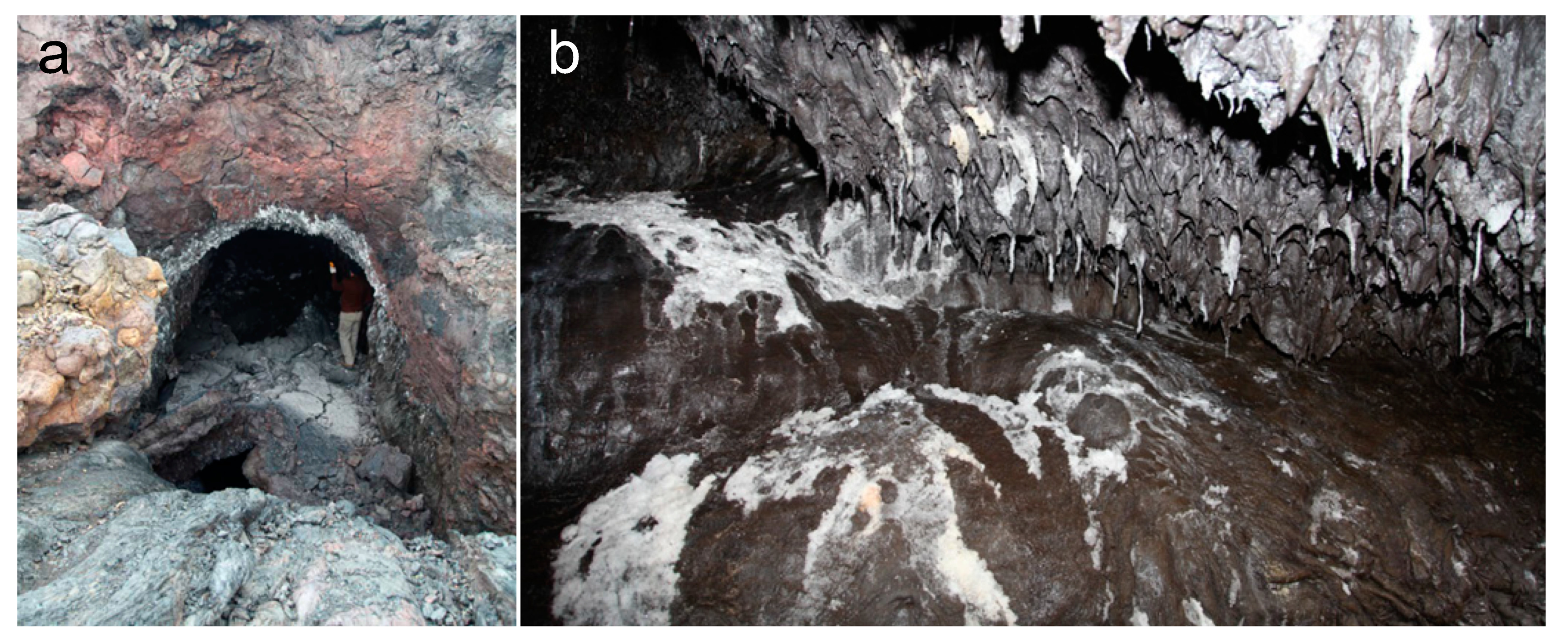
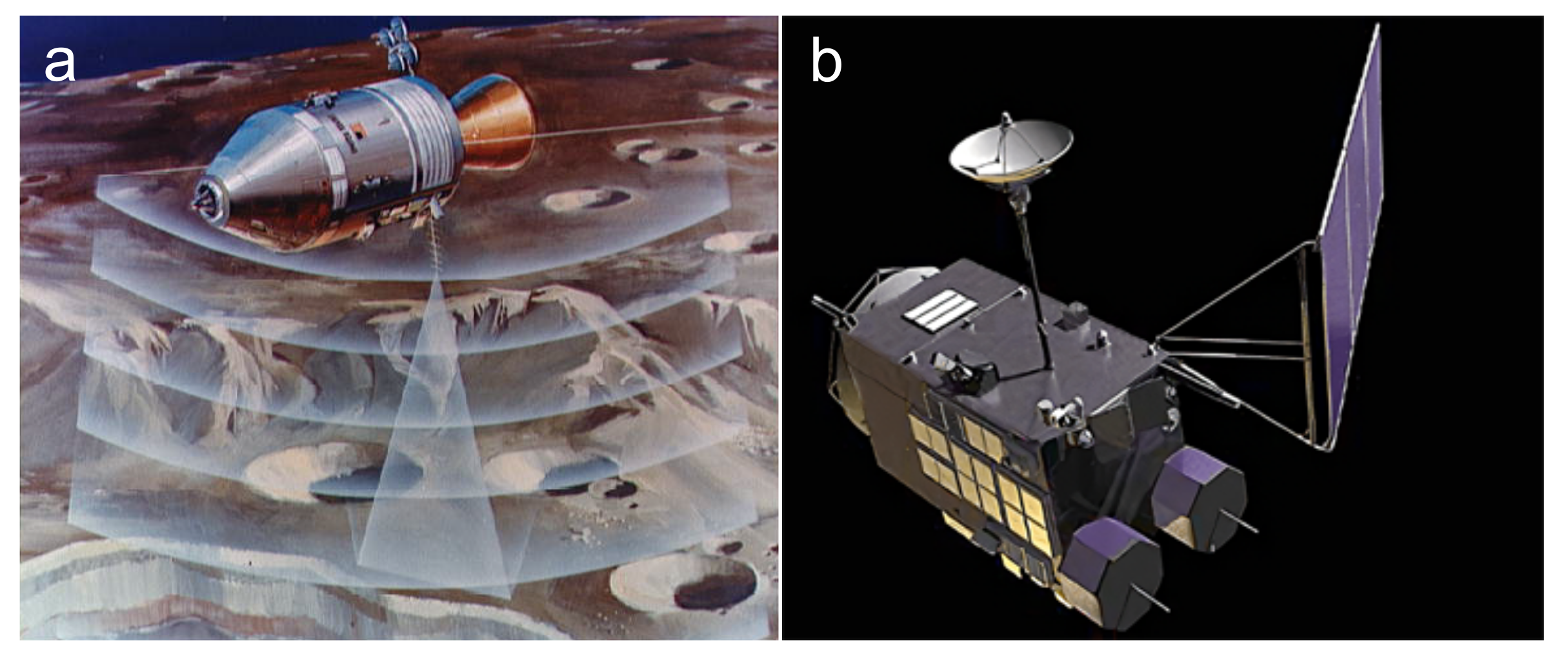


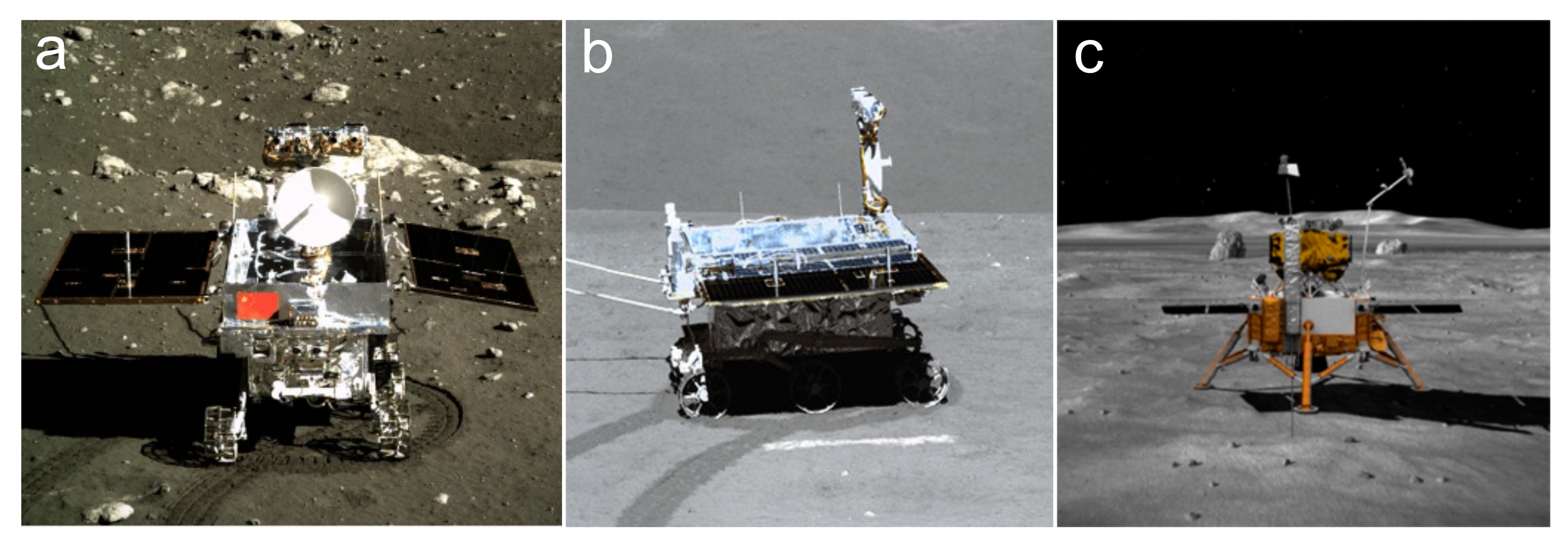
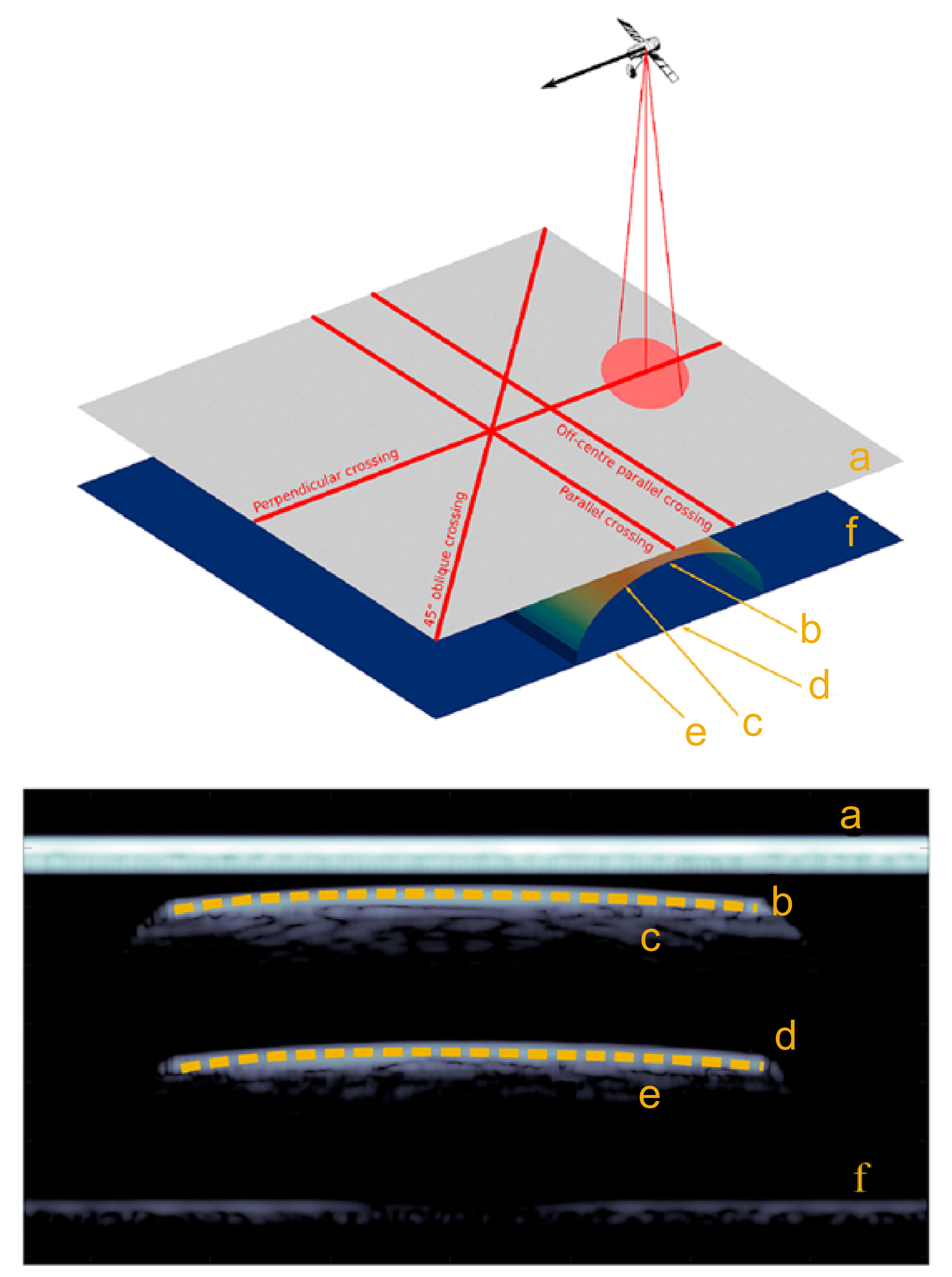
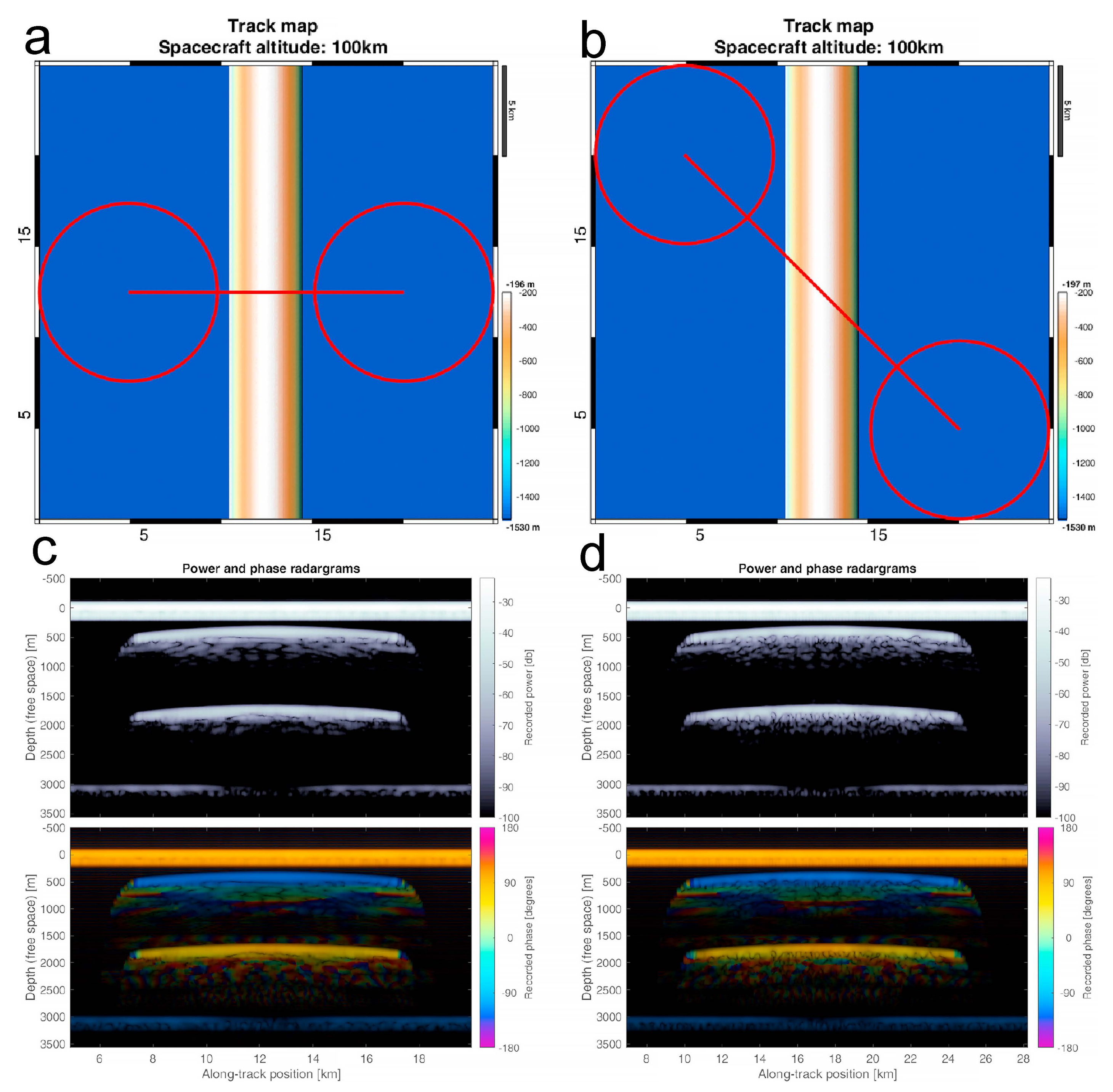
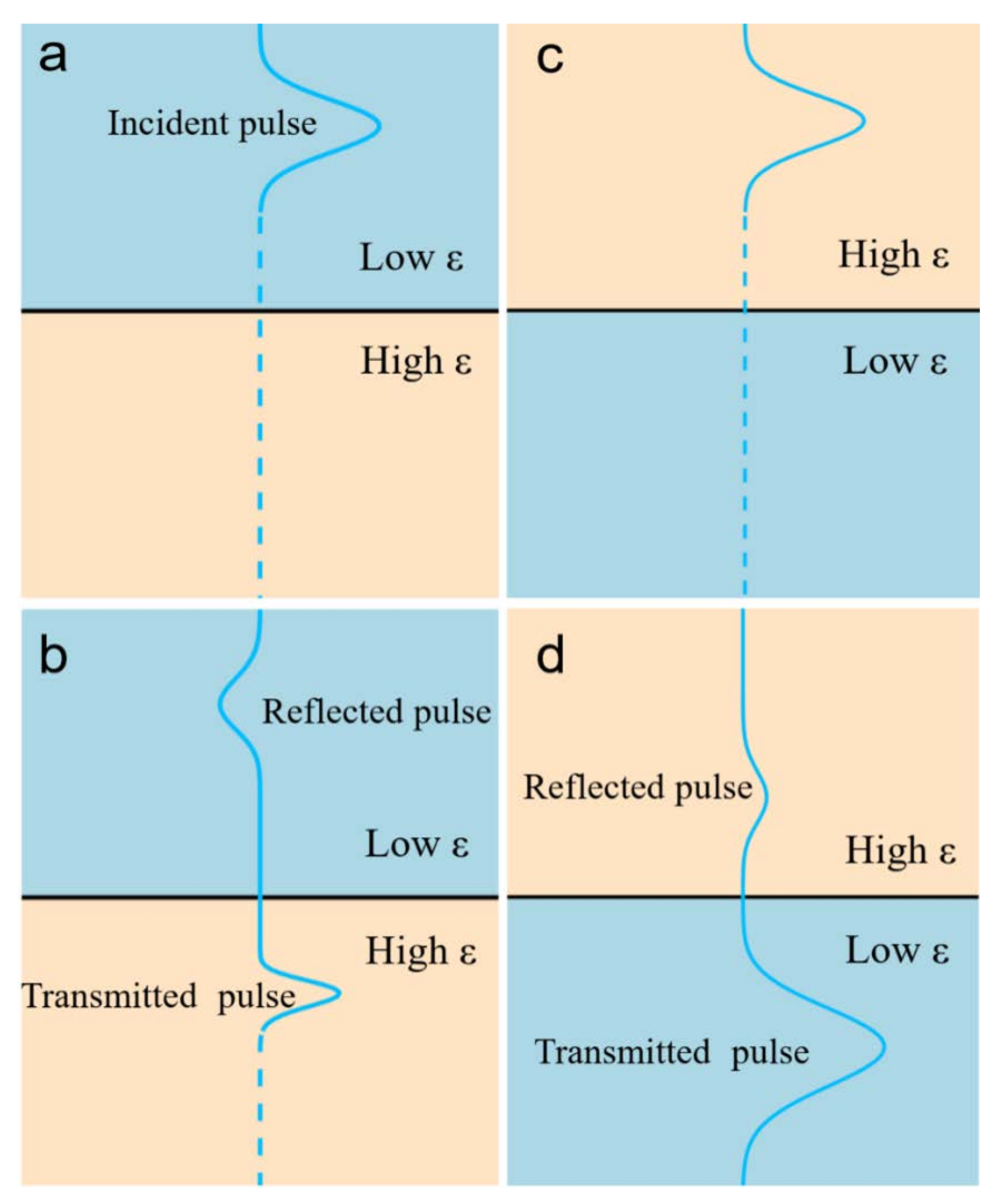
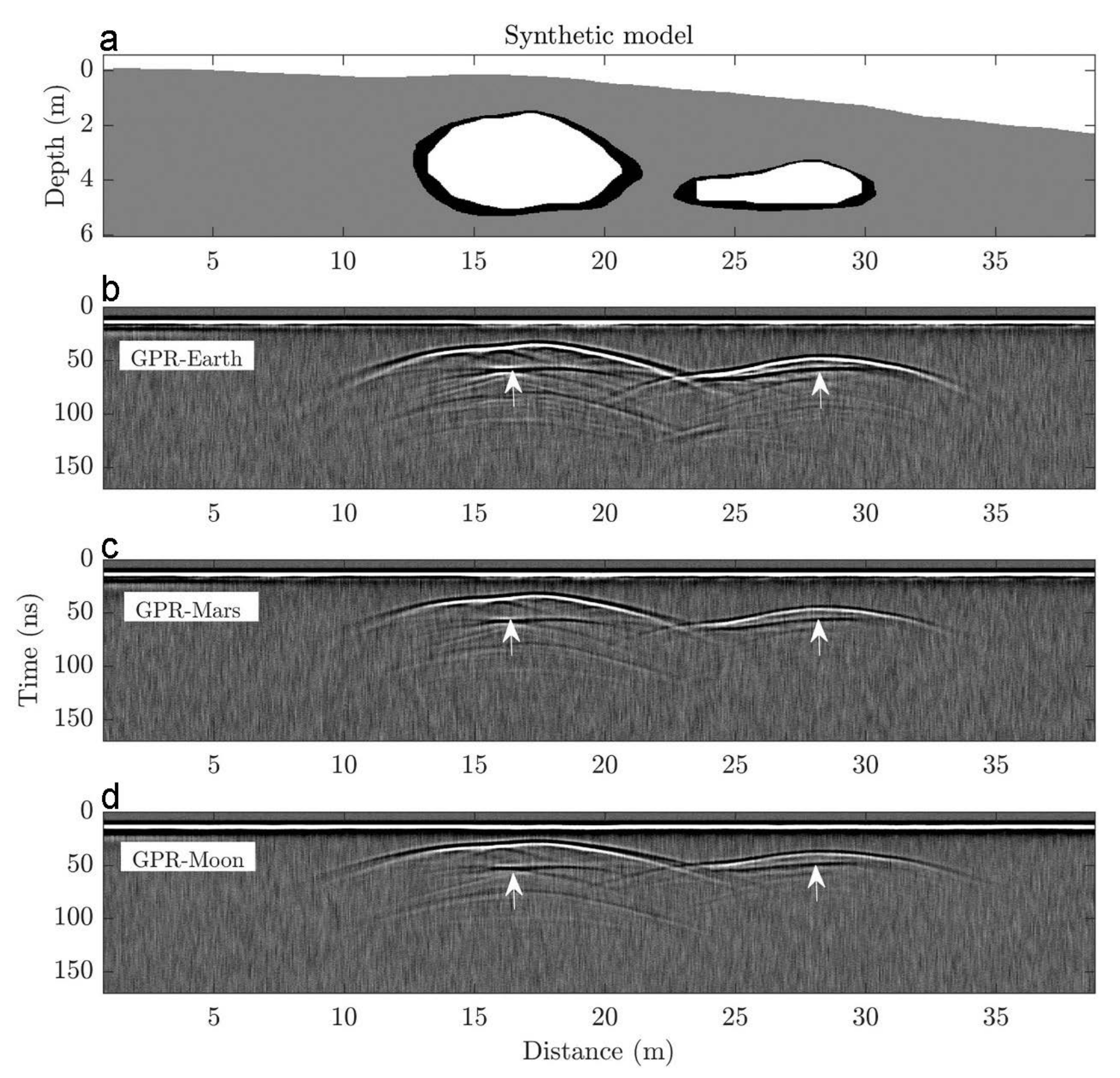

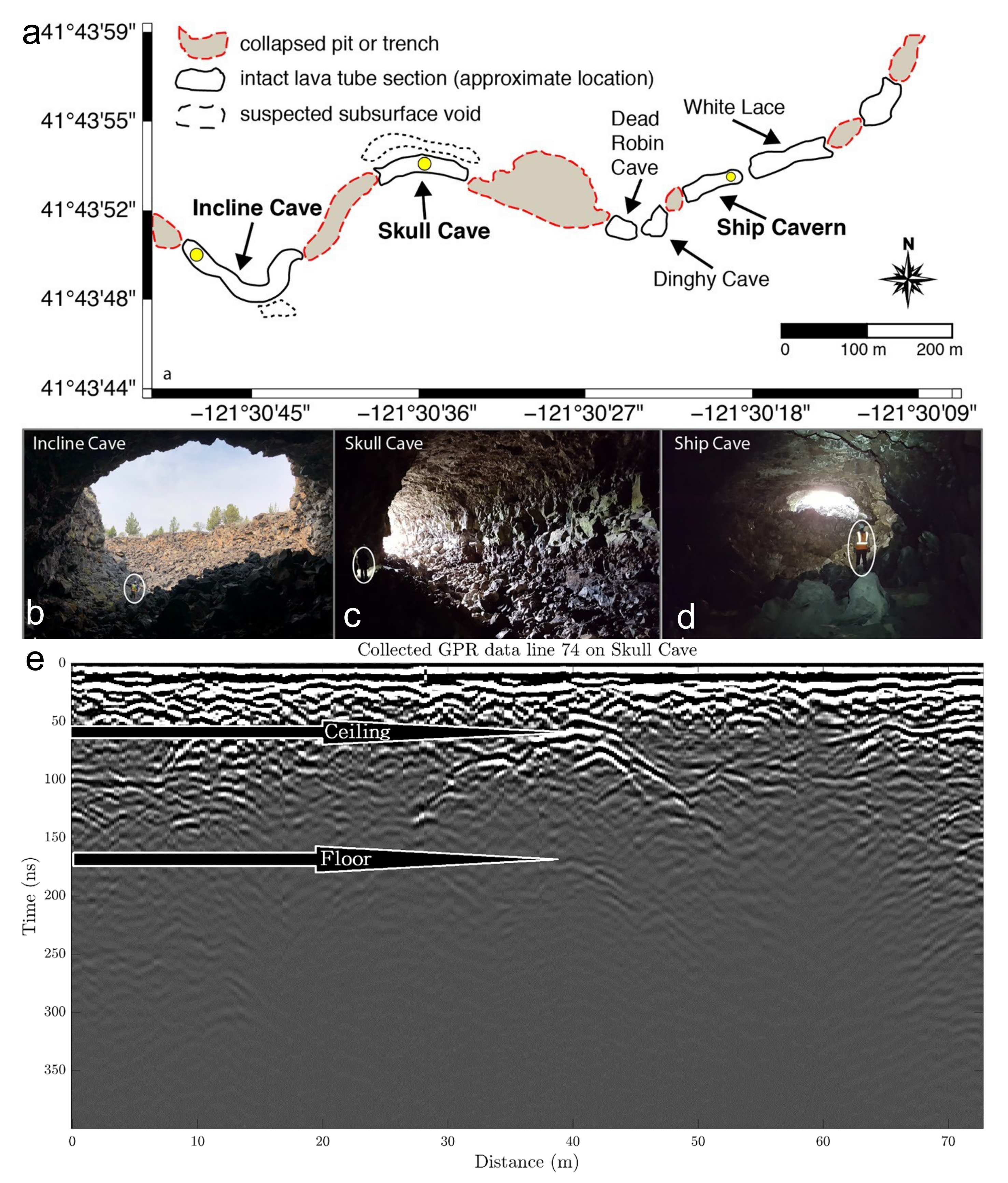
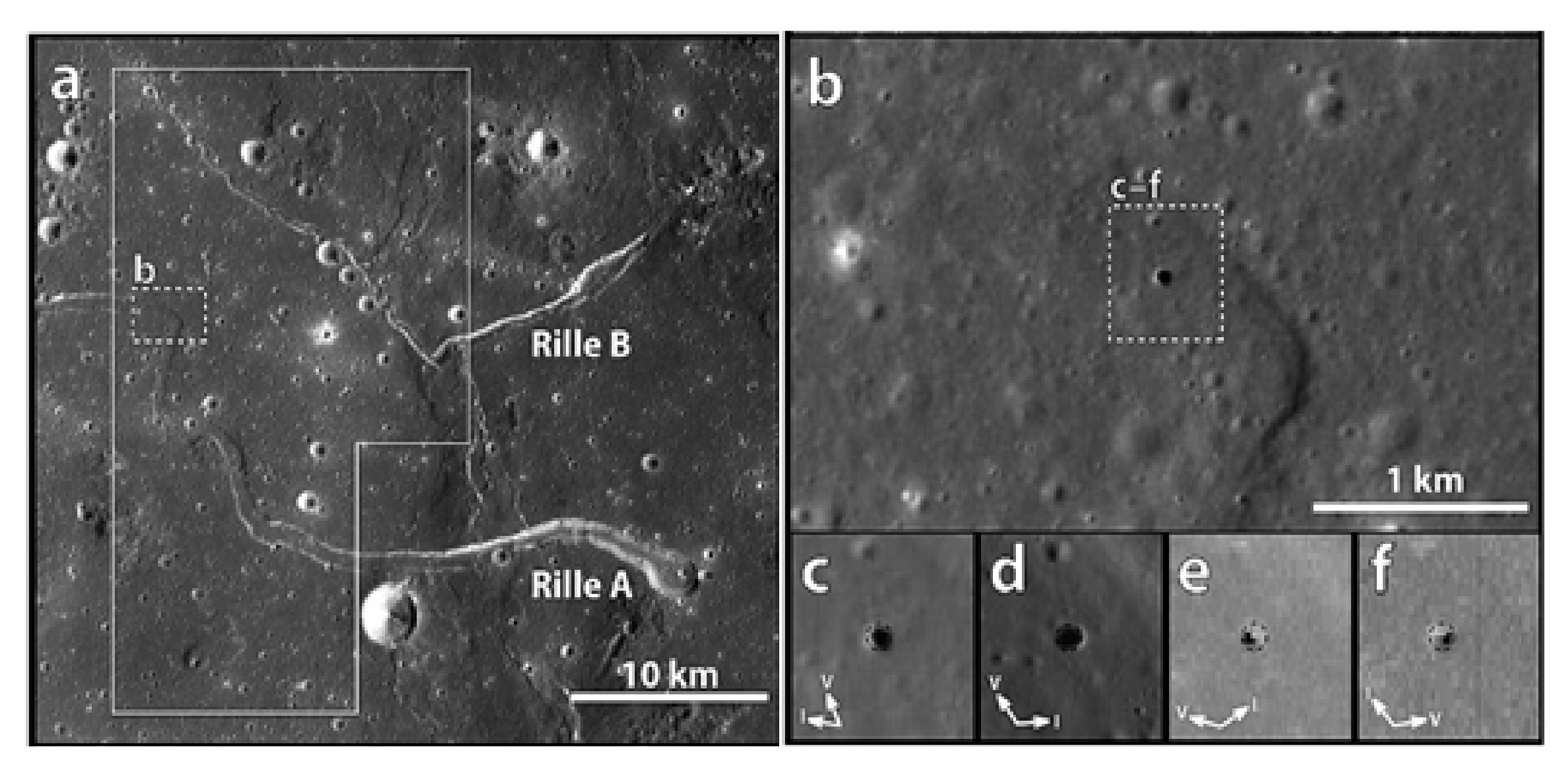


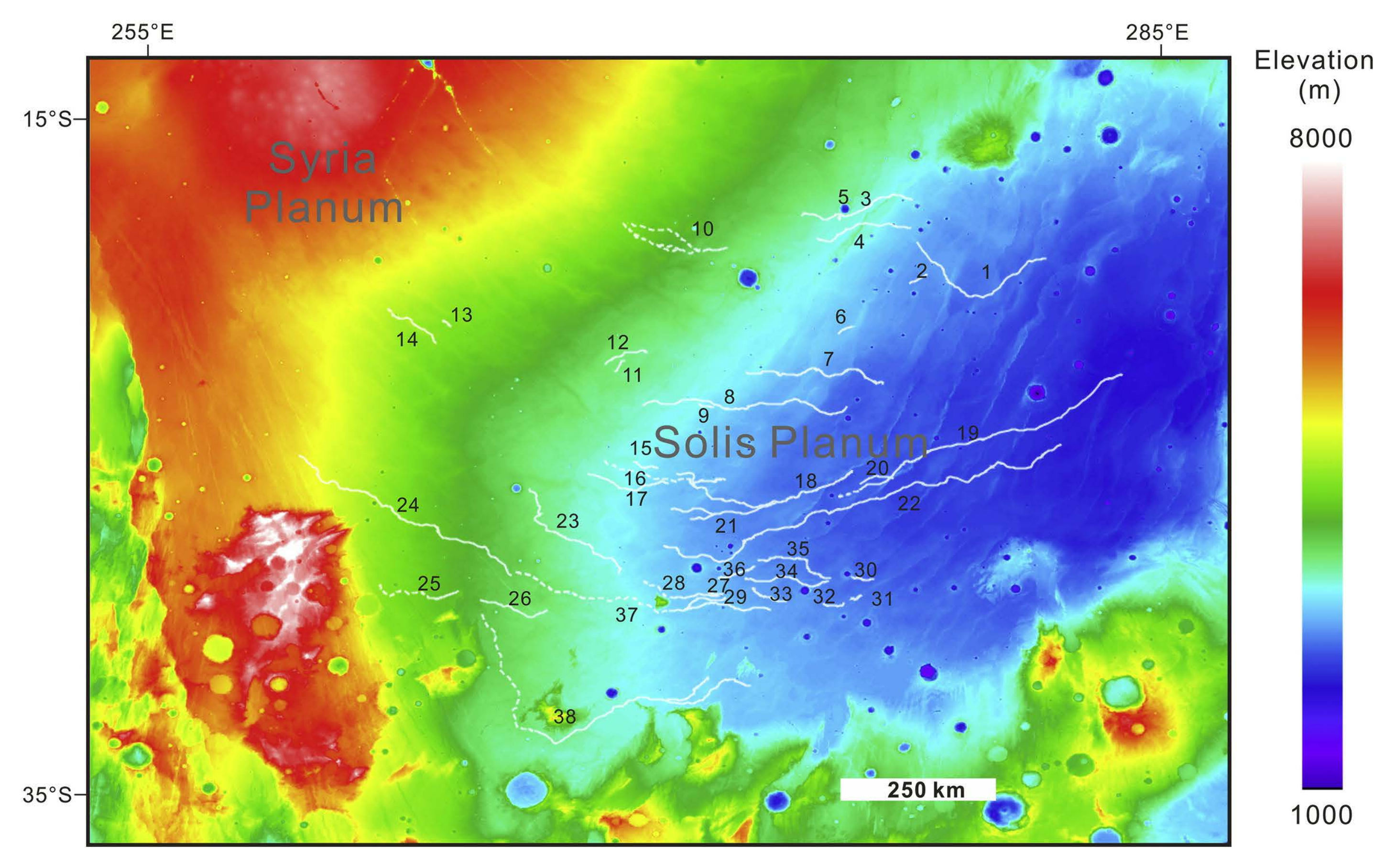
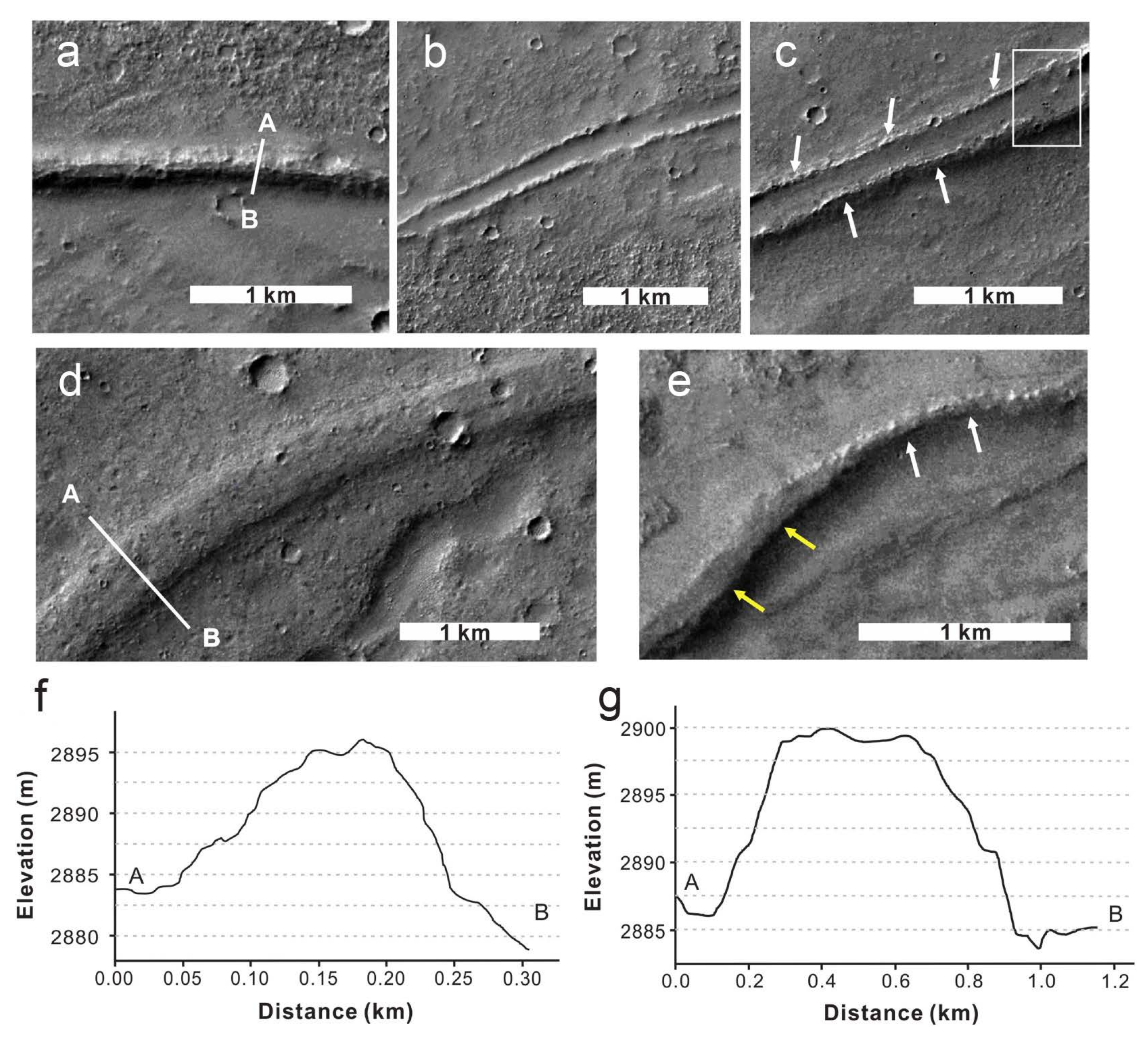
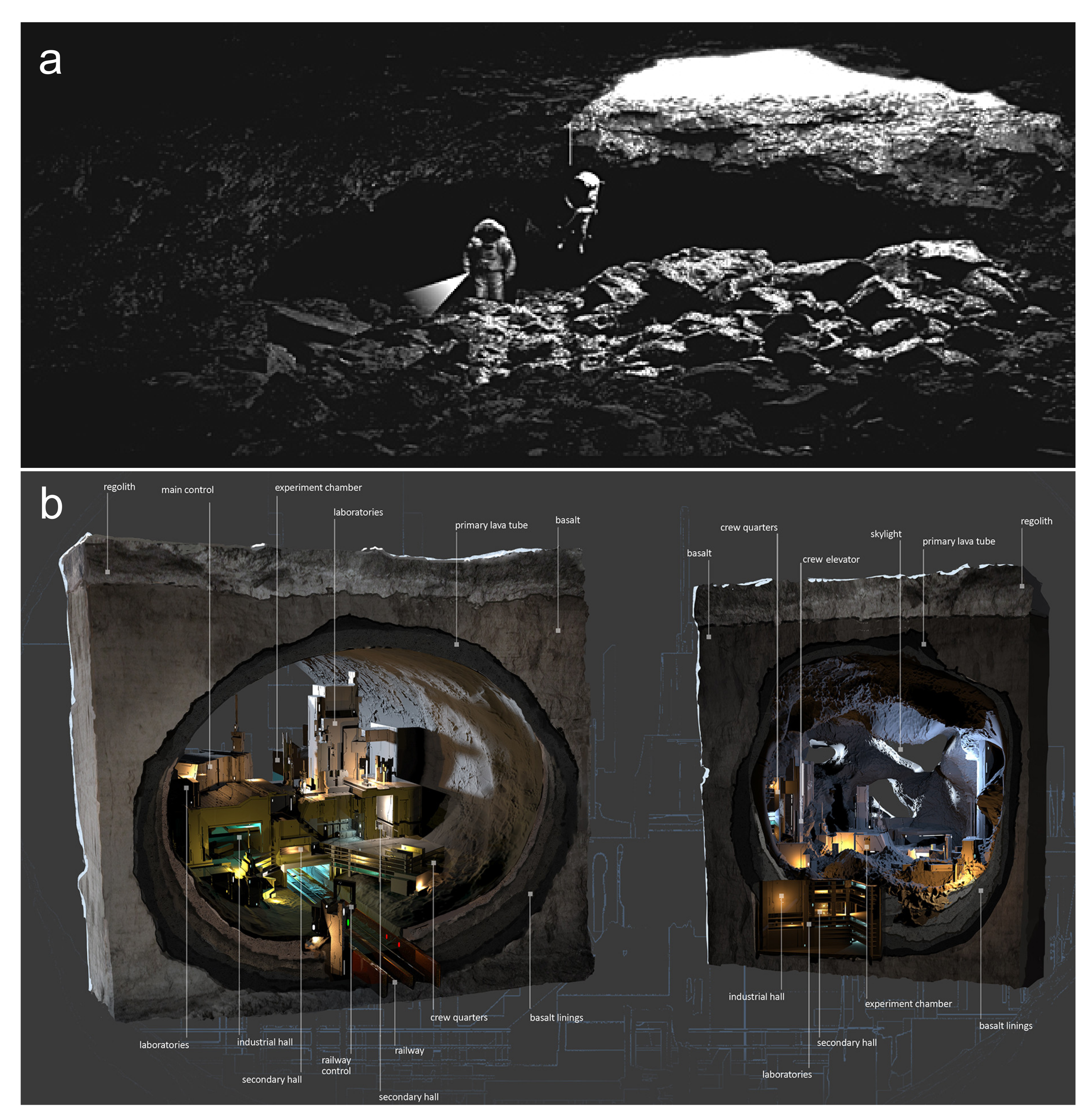
| Radar | ALSE | LRS | ||
|---|---|---|---|---|
| Orbiter | Apollo 17 | SELENE | ||
| Launch year | 1972 | 2007 | ||
| Status | HF1 | HF2 | VHF | – |
| Wavelength (m) | 60 | 20 | 2 | 60 |
| Center frequency (MHz) | 5.266 | 15.8 | 158 | 5 |
| Detection depth (m) | 1300 | 800 | 160 | 5000 |
| Vertical resolution (m) | 300 | 100 | 10 | 75 |
| Power (w) | 130 | 118 | 95 | 800 |
| Radar | MARSIS | SHARAD | MOSIR |
|---|---|---|---|
| Orbiter | Mars Express | Mars Reconnaissance | Tianwen–1 |
| Launch year | 2005 | 2006 | 2020 |
| Orbital altitude (km) | 250–900 | 250–300 | 265 |
| Center frequency (MHz) | 1.3–5.5 | 15–25 | LF: 10–20 HF: 30–50 |
| Detection depth (km) | 0.5–5 | 0.1–1 | 0.1–1 |
| Vertical resolution (m) | 150 | 15 | 30(LF)/7.5(HF) |
| Power (W) | 10 | 10 | ≥100 |
| Mission | CE–3/4 | CE–5 | CE–7 | ||
|---|---|---|---|---|---|
| Launch year | 2013/2018 | 2020 | 2026 (est.) | ||
| Status | LF | HF | – | LF | HF |
| Center frequency (MHz) | 60 | 500 | 2000 | 60 | 800 |
| Detection depth (m) | ≥100 | ≤30 | ≥2 | ≥400 | ≥40 |
| Thickness resolution (m) | Meter–sized | 0.3 | Centimeter–sized | 2 | 0.15 |
| Radar | RIMFAX | RoPeR | WISDOM | ||
|---|---|---|---|---|---|
| Rover | Perseverance | Zhurong | ExoMars | ||
| Launch Year | 2020 | 2020 | 2028 (est.) | ||
| Status | LF | HF | LF | HF | – |
| Center frequency (MHz) | 375 | 675 | 55 | 1300 | 1750 |
| Detection depth (m) | ≥10 | ≥10 | ≥3 | 3–10 | |
| Thickness resolution (cm) | 10–20 | 20–40 | Meter–sized | Centimeter–sized | 3 |
| Location | Coordinates | Data Source and Analysis Method | Reference |
|---|---|---|---|
| Marius | 14.2°N, 56.7°W | SELENE Image detection | Haruyama et al. [111] |
| Marius | 13.00–15.00°N, 55.99–58.15°W | SELENE Radar detection | Kaku et al. [19] |
| Mare Imbrium | 44.1214°N, 19.5116°W (CE–3 landing site) | Yutu rover Radar detection | Ding et al. [7] |
| Marius | 13.096°N, 57.056°W | Kaguya, LRO LOLA Image detection | Sauro et al. [8] |
| Gruithuisen | 34.618°N, 43.467°W | ||
| Hyginus Rill Tectonic | 8.384°N, 5.630°E |
| Location | Coordinates | Data Source and Analysis Method | Reference |
|---|---|---|---|
| Solis Planum | 15–35°S, 260–285°E | CTX, HiRISE Image detection | Zhao et al. [116] |
| Echus Chasma | 1.0°N, 278.0°E | SHARAD Radar detection | Mansilla et al. [117] |
| Arsia North | 3.062°S, 123.930°W | CTX, HiRISE Image detection | Sauro et al. [8] |
| Arsia South | 14.377°S, 119.949°W | CTX stereo–pairs, HiRISE Image detection | |
| Olympus | 19.456°N, 133.399°W | CTX stereo–pairs Image detection |
Disclaimer/Publisher’s Note: The statements, opinions and data contained in all publications are solely those of the individual author(s) and contributor(s) and not of MDPI and/or the editor(s). MDPI and/or the editor(s) disclaim responsibility for any injury to people or property resulting from any ideas, methods, instructions or products referred to in the content. |
© 2023 by the authors. Licensee MDPI, Basel, Switzerland. This article is an open access article distributed under the terms and conditions of the Creative Commons Attribution (CC BY) license (https://creativecommons.org/licenses/by/4.0/).
Share and Cite
Qiu, X.; Ding, C. Radar Observation of the Lava Tubes on the Moon and Mars. Remote Sens. 2023, 15, 2850. https://doi.org/10.3390/rs15112850
Qiu X, Ding C. Radar Observation of the Lava Tubes on the Moon and Mars. Remote Sensing. 2023; 15(11):2850. https://doi.org/10.3390/rs15112850
Chicago/Turabian StyleQiu, Xiaohang, and Chunyu Ding. 2023. "Radar Observation of the Lava Tubes on the Moon and Mars" Remote Sensing 15, no. 11: 2850. https://doi.org/10.3390/rs15112850









